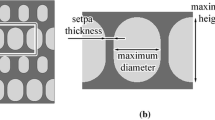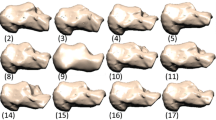Abstract
Plantar heel pain is one of the most common musculoskeletal disorders and generally causing long term discomfort of the patients. The objective of the present study is to combine in vivo experimental measurements and finite element modelling of the foot to investigate the influences of stiffness and thickness variation of individual plantar tissues especially the heel pad on deformation behaviours of the human foot. The stiffness and thickness variance of individuals were measured through supersonic shear wave elastography considering detailed heel pad layers refered to in literature as: dermis, stiffer micro-chamber layer, softer macro-chamber layer. A corresponding foot model with separated heel pad layers was established and used to a sensitivity analysis related to the variance of above-mentioned tissue characteristics. The experimental results show that the average stiffness of the micro-chamber layer ranged from 24.7 (SD 2.4) kPa to 18.8 (SD 3.5) kPa with the age group increasing from 20–29 years old to 60–69 years old, while the average macro-chamber stiffness is 10.6 (SD 1.5) kPa that appears to slightly decrease with the increasing age. Both plantar soft tissue stiffness and thickness of male were generally larger than that of female. The numerical simulation results show that the variance of heel pad strain level can reach 27.5% due to the effects of stiffness and thickness change of the plantar tissues. Their influences on the calcaneus stress and plantar pressure were also significant. This indicates that the most appreciate way to establish a personalized foot model needs to consider the difference of both individual foot anatomic geometry and plantar soft tissue material properties.









Similar content being viewed by others
References
Ahanchian, N., C. J. Nester, D. Howard, L. Ren, and D. Parker. Estimating the material properties of heel pad sub-layers using inverse finite element analysis. Med. Eng. Phys. 40:11, 2016.
Bandholm, T., L. Boysen, S. Haugaard, M. K. Zebis, and J. Bencke. Foot medial longitudinal-arch deformation during quiet standing and gait in subjects with medial tibial stress syndrome. J. Foot Ankle Surg. 47(2):89–95, 2008.
Bercoff, J., A. Criton, C. C. Bacrie, J. Souquet, M. Tanter, J. L. Gennisson, T. Deffieux, M. Fink, V. Juhan, and A. Colavolpe. ShearWave™ Elastography A new real time imaging mode for assessing quantitatively soft tissue viscoelasticity. Ultrasonics Symposium 2009
Birtane, M., and H. Tuna. The evaluation of plantar pressure distribution in obese and non-obese adults. Clin. Biomech. 19(10):1055–1059, 2004.
Bucki, M., V. Luboz, A. Perrier, E. Champion, B. Diot, N. Vuillerme, and Y. Payan. Clinical workflow for personalized foot pressure ulcer prevention. Med. Eng. Phys. 38(9):S135045331630073X, 2016.
Bus, S. A. Ground reaction forces and kinematics in distance running in older-aged men. Med. Sci. Sports Exerc. 35(7):1167–1175, 2003.
Buschmann, W. R., M. H. Jahss, F. Kummer, P. Desai, R. O. Gee, and J. L. Ricci. Histology and histomorphometric analysis of the normal and atrophic heel fat pad. Foot Ankle Int. 16(5):254–258, 1995.
Campanelli, V., F. Massimiliano, F. Niccolò, C. Alessio, P. Antonio, and S. Andrea. Three-dimensional morphology of heel fat pad: an in vivo computed tomography study. J. Anat. 219(5):622–631, 2011.
Cavanagh, P. R. Plantar soft tissue thickness during ground contact in walking. J. Biomech. 32(6):623–628, 1999.
Cavanagh, P. R., E. Morag, A. J. Boulton, M. J. Young, K. T. Deffner, and S. E. Pammer. The relationship of static foot structure to dynamic foot function. J. Biomech. 30:243–250, 1997.
Cavanagh, P. R., M. M. Rodgers, and A. Iiboshi. Pressure distribution under symptom-free feet during barefoot standing. Foot Ankle 7(5):262–276, 1987.
Chatzistergos, P. E., R. Naemi, and N. Chockalingam. A method for subject-specific modelling and optimisation of the cushioning properties of insole materials used in diabetic footwear. Med. Eng. Phys. 37(6):531–538, 2015.
Chen, W. M., and P. V. S. Lee. Explicit finite element modelling of heel pad mechanics in running: inclusion of body dynamics and application of physiological impact loads. Comput Method Biomech. 18(14):1582–1595, 2015.
Cheung, T. M., M. Zhang, and K. N. An. Effect of Achilles tendon loading on plantar fascia tension in the standing foot. Clin. Biomech. 21(2):194–203, 2006.
Cheung, J. T., M. Zhang, A. K. Leung, and Y. B. Fan. Three-dimensional finite element analysis of the foot during standing—a material sensitivity study. J. Biomech. 38(5):1045–1054, 2005.
Chih-Chin, H., T. Wen-Chung, W. Chung-Li, P. Sun-Hua, S. Yio-Wha, and C. Yu-Shuan. Microchambers and macrochambers in heel pads: are they functionally different? J. Appl. Physiol. 102(6):2227–2231, 2007.
Cotchett, M. P., G. Whittaker, and B. Erbas. Psychological variables associated with foot function and foot pain in patients with plantar heel pain. Clin. Rheumatol. 34(5):957–964, 2015.
Erdemir, A., M. L. Viveiros, J. S. Ulbrecht, and P. R. Cavanagh. An inverse finite-element model of heel-pad indentation. J. Biomech. 39(7):1279–1286, 2006.
Gangming, L., V. L. Houston, G. M. Anne, A. C. Beattie, and T. Chaiya. Finite element analysis of heel pad with insoles. J. Biomech. 44(8):1559–1565, 2011.
Gefen, A. Plantar soft tissue loading under the medial metatarsals in the standing diabetic foot. Med. Eng. Phys. 25(6):491–499, 2003.
Genevieve, S., H. B. Menz, and N. Lesley. Age-related differences in foot structure and function. Gait Posture 26(1):0–75, 2007.
Grigoriadis, G., N. Newell, D. Carpanen, A. Christou, A. M. J. Bull, and S. D. Masouros. Material properties of the heel fat pad across strain rates. J. Mech. Behav. Biomed. Mater. 65:398–407, 2017.
Hsu, C. C., C. P. Chen, S. C. Lin, W. C. Tsai, H. T. Liu, Y. C. Lin, H. J. Lee, and W. P. Chen. Determination of the augmentation effects of hyaluronic acid on different heel structures in amputated lower limbs of diabetic patients using ultrasound elastography. Ultrasound Med. Biol. 38(6):943–952, 2012.
Hsu, C. C., W. C. Tsai, P. C. Chen, Y. W. Shau, C. L. Wang, J. L. Chen, and K. J. Chang. Effects of aging on the plantar soft tissue properties under the metatarsal heads at different impact velocities. Ultrasound Med. Biol. 31(10):1423–1429, 2005.
Hsu, C. C., W. C. Tsai, T. Y. Hsiao, F. Y. Tseng, Y. W. Shau, C. L. Wang, and S. C. Lin. Diabetic effects on microchambers and macrochambers tissue properties in human heel pads. Clin. Biomech. 24(8):682–686, 2009.
Jacob, S., and M. K. Patil. Stress analysis in three-dimensional foot models of normal and diabetic neuropathy. Front. Med. Biol. Eng. 9(3):211–227, 1999.
Jahss, M. H., J. D. Michelson, P. Desai, R. Kaye, F. Kummer, W. Buschman, F. Watkins, and S. Reich. Investigations into the fat pads of the sole of the foot: anatomy and histology. Foot Ankle 13(5):233–242, 1992.
Jérémy, B., T. Mickael, and F. Mathias. Supersonic shear imaging: a new technique for soft tissue elasticity mapping. IEEE T. Ultrason. FERR. 51(4):396–409, 2004.
Kwan, L. C., Y. P. Zheng, and L. Y. Cheing. The effect of aging on the biomechanical properties of plantar soft tissues. Clin. Biomech. 25(6):601–605, 2010.
Lin, C. Y., C. C. Lin, Y. C. Chou, P. Y. Chen, and C. L. Wang. Heel pad stiffness in plantar heel pain by shear wave elastography. Ultrasound Med. Biol. 41(11):2890–2898, 2015.
Linder-Ganz, E., N. Shabshin, Y. Itzchak, Z. Yizhar, I. Siev-Ner, and A. Gefen. Strains and stresses in sub-dermal tissues of the buttocks are greater in paraplegics than in healthy during sitting. J. Biomech. 41(3):567–580, 2008.
Luboz, V., A. Perrier, M. Bucki, B. Diot, F. Cannard, N. Vuillerme, and Y. Payan. Influence of the calcaneus shape on the risk of posterior heel ulcer using 3D patient-specific biomechanical modeling. Ann. Biomed. Eng. 43(2):1–11, 2014.
McPoil, T. G., R. L. Martin, M. W. Cornwall, D. K. Wukich, J. J. Irrgang, and J. J. Godges. Heel pain—plantar fasciitis: clinical practice guildelines linked to the international classification of function, disability, and health from the orthopaedic section of the American Physical Therapy Association. J. Orthop. Sports Phys. Ther. 85A:872–877, 2008.
MillerYoung, J. E., N. A. Duncan, and G. Baroud. Material properties of the human calcaneal fat pad in compression: experiment and theory. J. Biomech. 35(12):1523–1531, 2002.
Mo, F., F. Li, M. Behr, Z. Xiao, G. J. Zhang, and X. P. Du. A lower limb-pelvis finite element model with 3D active muscles. Ann. Biomed. Eng. 46(1):86–96, 2018.
Nakamura, S., and R. D. Crowninshield. An analysis of soft tissue loading in the foot. J. Biomech. 14(7):492, 1981.
Prichasuk, S. The heel pad in plantar heel pain. J. Bone Jt. Surg. Br. 76(1):140, 1994.
Riddle, D. L., M. Pulisic, P. Pidcoe, and R. E. Johnson. Risk factors for plantar fasciitis: a matched case–control study. J. Bone Joint Surg. Am. 85A:872–877, 2003.
Rome, K. Mechanical properties of the heel pad: current theory and review of the literature. Foot. 8(4):179–185, 1998.
Siegler, S., J. Block, and C. D. Schneck. The mechanical characteristics of the collateral ligaments of the human ankle joint. Foot Ankle. 8(5):234, 1988.
Snehal, C., J. P. Halloran, A. J. V. D. Bogert, and E. Ahmet. A three-dimensional inverse finite element analysis of the heel pad. J. Biomech. Eng. 134(3):031002, 2012.
Tsai, W. C., C. L. Wang, T. C. Hsu, F. J. Hsieh, and F. T. Tang. The mechanical properties of the heel pad in unilateral plantar heel pain syndrome. Foot Ankle Int. 20(10):663–668, 1999.
Wang, C. L., C. Y. Lin, P. Y. Chen, Y. W. Shau, and H. C. Tai. Spatial-dependent mechanical properties of the heel pad by shear wave elastography. Ultrasound Med. Biol. 43:S89–S90, 2017.
Williams, D. S., and I. S. McClay. Measurements used to characterize the foot and the medial longitudinal arch: reliability and validity. Phys. Ther. 80(9):864–871, 2000.
Wong, D. W., W. Niu, Y. Wang, and M. Zhang. Finite element analysis of foot and ankle impact injury: risk evaluation of calcaneus and talus fracture. PLoS ONE 11(4):e0154435, 2016.
Wren, T. A. L., S. A. Yerby, G. S. Beaupré, and D. R. Carter. Mechanical properties of the human achilles tendon. Clin. Biomech. 16(3):245–251, 2001.
Wright, D. G., and D. C. Rennels. A study of elastic properties of plantar fascia. J. Bone Jt. Surg. Am. Vol. 46(1–4):482, 1964.
Wu, C. H., C. Y. Lin, M. Y. Hsiao, Y. H. Cheng, W. S. Chen, and T. G. Wang. Altered stiffness of microchamber and macrochamber layers in the aged heel pad: Shear wave ultrasound elastography evaluation. J. Formos. Med. Assoc. 117(5):S0929664617301511, 2017.
Yak-Nam, W., L. Kara, and W. R. Ledoux. Histomorphological evaluation of diabetic and non-diabetic plantar soft tissue. Foot Ankle Int. 32(08):802–810, 2011.
Zhang, M., and A. F. Mak. In vivo friction properties of human skin. Prosthet. Orthot. Int. 23(2):135, 1999.
Acknowledgments
This study was supported by National Natural Science Foundation of China (Grant Nos. 51875187, 51621004), and Hunan Province Science and Technology Plan (Grant No. 2019JJ40021).
Author information
Authors and Affiliations
Corresponding author
Additional information
Associate Editor Estefanía Peña oversaw the review of this article.
Publisher's Note
Springer Nature remains neutral with regard to jurisdictional claims in published maps and institutional affiliations.
Rights and permissions
About this article
Cite this article
Mo, F., Li, J., Yang, Z. et al. In Vivo Measurement of Plantar Tissue Characteristics and Its Indication for Foot Modeling. Ann Biomed Eng 47, 2356–2371 (2019). https://doi.org/10.1007/s10439-019-02314-0
Received:
Accepted:
Published:
Issue Date:
DOI: https://doi.org/10.1007/s10439-019-02314-0






